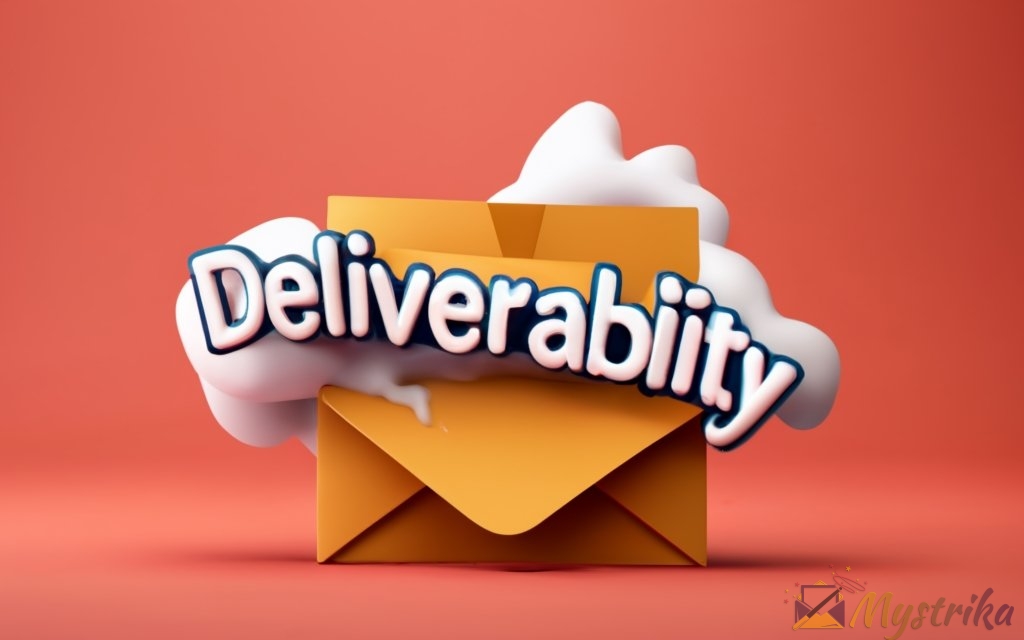For email marketers, the inbox is the holy grail. But with so many obstacles blocking the path to delivery, achieving high email deliverability can feel like an epic quest. Join us on an journey to conquer cluttered inboxes across the land and reliably reach recipients with campaigns that drive results.
In this comprehensive guide, we’ll equip you with email deliverability best practices to vanquish spam filters, slay bounces, and defeat deliverability dragons of all kinds. Master essential techniques like list building, engagement monitoring, and reputation management to ensure your hard work pays off with emails that consistently land in inboxes. Let’s embark on the adventure!
Defining Email Deliverability and Why It Matters
Email deliverability refers to the likelihood that an email message will make it to the intended recipient’s inbox as opposed to getting filtered to the spam folder or bouncing back to the sender. For email marketers, achieving excellent deliverability is crucial for ensuring that carefully crafted campaigns and valuable messages actually reach subscribers. But what exactly constitutes “good” deliverability, and why does it matter so much?
What is Email Deliverability?
In simple terms, email deliverability is a measure of how often your emails arrive successfully in subscribers’ inboxes.
Deliverability depends largely on your sender reputation – essentially, how much inbox providers like Gmail trust messages from your domain or IP address. If you have a poor reputation due to spammy behavior, low engagement, or other issues, your emails are more likely to get blocked or filtered to spam.
Some key metrics used to evaluate deliverability performance include:
- Bounce rate: What percentage of sent emails bounce back and fail to reach recipients’ inboxes at all? Both “hard” bounces (invalid addresses) and “soft” bounces (temporary issues like full inboxes) hurt your deliverability.
- Delivery rate: What percentage of emails arrive without bouncing? Industry experts recommend striving for at least a 95% delivery rate.
- Inbox placement rate: Of delivered emails, what percentage bypass the spam folder and reach the primary inbox? This is the truest measure of deliverability success.
- Spam rate: What percentage of emails get flagged as spam? Staying under 0.1% spam complaints is ideal.
So in summary, the higher your delivery and inbox rates, and the lower your bounce and spam rates, the better your overall email deliverability.
Why Email Deliverability is Critical for Marketers
Email is still one of the most effective marketing channels available. But even the most captivating message and compelling subject line are useless if your email never makes it to subscribers’ inboxes.
Some key reasons delivering to the inbox matters:
- Increased revenue opportunities: Emails filtered as spam or blocked outright eliminate chances for clicks, conversions, and sales.
- Improved campaign performance: Low open and click-through rates due to deliverability issues distort campaign metrics and performance.
- Enhanced sender reputation: Consistently hitting the inbox strengthens your domain’s reputation over time, further improving deliverability.
- Subscriber satisfaction: Missing emails leads to confusion and frustration, damaging subscriber relationships.
- Compliance: Delivery failures could mean violating anti-spam laws if you fail to honor opt-out requests.
- Data quality: Bounced emails due to invalid addresses distort list metrics and segment data.
- Cost savings: Optimizing deliverability reduces waste from sending emails that never reach recipients.
In short, prioritizing inbox placement ensures email campaigns live up to their revenue-driving, engagement-boosting potential while building your brand reputation and subscriber trust over time.
How Email Deliverability is Measured
Email service providers (ESPs) and inbox analytics tools track an array of metrics that can be used to evaluate and monitor the health of your email program’s deliverability:
- Bounce rate: As mentioned above, this is the percentage of emails that fail to get delivered and bounce back to the sender. Bounce rates above 3% often indicate deliverability issues.
- Soft vs. hard bounce rate: Analyzing bounce types separately provides more insight. Temporary soft bounces are less problematic than permanent hard bounces signaling invalid addresses.
- Delivery or acceptance rate: What percentage of sent emails are accepted by recipients’ mail servers, without bouncing? Above 95% is strong.
- Spam rate: The percentage of emails flagged or marked as spam by recipients. Below 0.1% is ideal, with under 0.02% being excellent.
- Unsubscribe rate: A high unsubscribe rate signals recipient dissatisfaction or irrelevant content. Keep it below 0.5%.
- Unique click rate: The percentage of subscribers who clicked any link in a given campaign. Higher is better, but compare to your industry benchmarks.
- Open rate: What percentage of recipients opened the email? Above 20% is good, with 30% or higher being exceptional.
- Inbox placement rate: Possibly the most telling metric, tracking the rate of emails arriving successfully in the primary inbox. 90%+ is strong.
Analyzing and optimizing these key email deliverability metrics is crucial to assessing the health of your sender reputation and ensuring your messages reliably reach subscriber inboxes going forward.

Key Factors That Influence Email Deliverability
Achieving excellent email deliverability that consistently lands your messages in subscribers’ inboxes depends on several key factors. Optimizing these elements establishes trust and maximizes the chances your emails bypass spam filters.
Sender Reputation and Trust
Your domain and IP address’s sender reputation is arguably the single most important factor determining inbox placement.
How sender reputation works:
- Inbox providers assign reputations based on past sending behavior and metrics.
- High volumes of spam complaints or bounces damage your reputation.
- Reputations influence whether emails get delivered or filtered as spam.
- New domains and IPs start with a neutral reputation and are evaluated over time.
Tips for managing sender reputation:
- Warm up new IPs by gradually increasing sending volume. Sudden spikes look suspicious.
- Keep lists clean and segmented to ensure engaged recipients. Low opens hurt reputation.
- Monitor and optimize engagement and complaint rates.
- Use dedicated IPs for marketing and transactional email.
- Avoid spam traps, which signal poor list quality.
- Follow anti-spam regulations and authentication protocols.
Overall, acting responsibly over time earns inbox providers’ trust, while risky email practices degrade your sender reputation. Prioritize subscriber satisfaction and aim to exceed industry standards across all reputation-related metrics.
List Quality and Hygiene
Your email list is the foundation of all your deliverability efforts. Low-quality lists lead directly to bounces, spam complaints, and blocks by inbox providers.
Follow these list management best practices:
- Never purchase or rent email lists. These often contain spam traps or invalid emails.
- Always confirm opt-in and obtain explicit consent before adding anyone.
- Verify email validity upon signup via double opt-in and other checks.
- Segment your list based on engagement level and preferences. Only email relevant content.
- Regularly purge incomplete, unengaged, bounced, and complained-about email addresses.
- Delete or re-permission emails inactive for 6+ months, which may be spam traps.
- Avoid sending to generic role addresses like info@ or sales@.
- Use address warming when mailing previously inactive subscribers to re-engage.
- Monitor your list’s overall health by tracking metrics like unique opens, click rates, soft and hard bounce rates, and spam complaints. Diagnose any deterioration and take corrective actions.
In summary, an accurate, segmented list containing only engaged recipients who want your emails ensures maximum deliverability. Regular list hygiene is essential.
Email Authentication Protocols
Email authentication verifies your domain as a legitimate sender, which helps bypass spam filters. The main protocols are:
- SPF (Sender Policy Framework): Publishes approved sending servers via DNS records. Prevents spoofing.
- DKIM (DomainKeys Identified Mail): Cryptographically signs emails to confirm legitimacy.
- DMARC (Domain-based Message Authentication): Aligns SPF and DKIM to prevent spoofing. Specifies handling of failed messages.
- BIMI: Displays company brand logo in authenticated emails. Requires DMARC. Improves engagement.
Benefits of proper authentication:
- Lowers spam score from filters like SpamAssassin.
- Reduces chances of spoofing and phishing attempts.
- Signals your domain’s legitimacy as a sender to inbox providers.
- Improves deliverability and avoids extra spam filtering scrutiny.
How to implement:
- Use your email service provider’s tools and ensure DNS records are set up properly.
- Start with SPF, then expand to DKIM and DMARC for added protection.
- Set DMARC policies to reject or quarantine failed messages. Avoid “none”.
- Check authentication using ESP tools or external analyzers to catch issues.
Proper authentication is vital for deliverability and protecting brand reputation when combined with good sending behavior. Prioritize implementing these protocols.
Infrastructure Reliability
The technical components involved in routing your emails also impact deliverability. Follow these infrastructure best practices:
Invest in robust email infrastructure: Prioritize delivery by choosing an enterprise-grade ESP over cheaper, less reliable options. Avoid do-it-yourself configurations prone to issues.
Maintain continuity: Using consistent IPs and domains is better than frequent changes, which raise spam suspicions. Warm up new IPs gradually.
Prioritize security: Encrypt connections, authenticate emails, and safeguard servers to avoid being flagged as malicious.
Plan for scale: Infrastructure needs to handle your peak volumes across busy campaigns. Set up dedicated IPs in advance of growth milestones.
Monitor performance: Watch for delayed emails, throttling, excessive bounces, or odd traffic patterns indicating infrastructure problems. Stay ahead of issues.
Update configurations: Keep DNS records, firewall settings, and email servers up to date to avoid technical delivery problems.
While less exciting than creative messaging, optimizing these structural elements prevents deliverability snags down the line.
Message Content and Format
While your sender reputation carries more weight, the content of your emails still impacts deliverability in some ways:
Avoid spam trigger words: Spam filters check messages for suspicious terms commonly found in spam. Avoid potentially risky words and phrases.
Ensure proper formatting: Stick to HTML formatting standards. Bad HTML, mismatched links, or images hosted on suspicious domains can hurt deliverability.
Moderate image usage: Too many images compared to text raises spam suspicions. But some visuals boost engagement. Shoot for a 60/40 text-to-image ratio.
Focus on value: Engaging subject lines and valuable content increase opens and clicks, indirectly supporting deliverability through better engagement metrics.
Facilitate sharing: Make it easy to forward your emails or share on social media. Higher forwarding rates signal quality content to inbox providers.
Personalize carefully: While personalization boosts engagement, avoid anything that seems invasive until you build subscriber trust. Consider a graduated approach.
Check renderability: Ensure your emails display properly across different devices, clients, and browsers. Reliable rendering improves deliverability and opens.
Overall, clean formatting, strong engagement, and avoiding spammy content keeps your messages out of the spam folder. But reputation carries more weight than message factors.
Engagement and Complaint Rates
How your recipients interact with your emails also impacts future deliverability by shaping your sender reputation.
Monitor engagement metrics: Inbox providers notice if few recipients open or click your emails. Very low engagement hurts your reputation.
Keep spam complaints low: Complaint rates above 0.1% raise red flags. Make unsubscribing easy to avoid frustrated recipients clicking “spam.”
Manage unsubscribes: A high unsubscribe rate signals irrelevant content or dissatisfaction. But don’t make it hard to unsubscribe, or complaints rise.
Review prior actions: If a recipient deletes emails without opening or immediately marks it read, your reputation suffers. Monitor this behavior.
Check responses: Does no one reply to your emails? Lack of responses equates to low engagement. Boost interaction and response.
Reward positive actions: Recipients adding you to their address book signals you send valued content. Call out this option in emails.
In summary, monitoring how your subscribers interact with your emails provides an early warning system for deliverability issues and helps refine your approach. Keep a close eye on complaint rates in particular.

Understanding the Email Delivery Process
Before an email reaches the recipient’s inbox, it must pass through a series of steps, each critical to the message’s deliverability. Understanding this journey helps identify where issues arise. Let’s walk through what happens during email transmission and delivery from start to finish.
Building Your Contact List
The first step in the email delivery process happens before you even draft your first campaign. You must build your list of recipient email addresses.
How you build your list greatly influences future deliverability.
The best approach is to:
- Organically collect contacts who opt-in to your emails via forms.
- Confirm valid, working addresses via double opt-in.
- Avoid purchasing or scraping lists, which likely contain spam traps.
- Segment contacts based on preferences and engagement.
- Assign dedicated series for less engaged segments to limit messages.
In other words, compile a targeted list of subscribers truly interested in hearing from you. This prevents bounces, spam complaints, and blocks down the line.
Sending the Email
Once your campaign is prepped, it’s time to hit send. This stage sets deliverability in motion.
At the point of transmission, several factors influence inbox placement:
- Your domain and IP reputation – A strong reputation means trusting you more to bypass spam filters.
- List quality – Good lists minimize bounces and complaints during this step.
- Infrastructure – Reliable email servers with proper configuration optimize delivery.
- Authentication – Valid SPF, DKIM, and DMARC records confirm you as a legitimate sender.
Provided your reputation is solid and configurations correct, most emails should transmit successfully during this phase. Proper list hygiene and engaging content give you an added boost.
Delivery and Potential Bounces
Next, your email provider attempts to deliver the transmitted messages to recipients’ servers. At this stage, bounces eliminate some emails.
Delivery success depends on:
- List accuracy – Invalid or mistyped addresses trigger hard bounces.
- Infrastructure – Network outages or undocumented IP changes lead to bounces.
- Sending volume – Spikes above normal levels often get soft bounced as suspicious.
- Engagement history – Previously inactive emails may be soft bounced until re-activated.
With a healthy list and infrastructure, most emails should be accepted during delivery. Monitor soft and hard bounce rates at this stage to catch any issues.
Inbox Placement or Spam Filtering
For emails that are successfully delivered, the next challenge is bypassing spam filters and landing in inboxes.
Inbox providers evaluate many factors when filtering emails:
- Reputation – Good reputations mean less filtering scrutiny. Newer senders get more attention.
- Authentication – Proper SPF, DKIM, and DMARC improve the chances of inbox placement.
- Engagement history – Low opens or clicks increase chances of going to spam.
- List quality – Spam traps or complaints prompt aggressive filtering.
- Sending patterns – Volume spikes raise red flags.
- Content – Spammy language, formatting issues, or excessive images can hurt.
Monitor inbox placement rate to optimize delivery during this crucial stage. Authentication, reputation, and engagement have the biggest impact.
Email Opened or Left Unopened
For emails that make it to the inbox, recipients will either open it or leave it unopened.
Factors influencing open rate include:
- Subject line – Compelling, relevant subject lines boost open rates.
- Preview text – Preview text visibility varies but helps pique interest.
- Reputation – Being labeled a trusted sender increases opens.
- Engagement history – Recently engaged subscribers are more likely to open.
- List quality – Bad addresses can’t open so distort open rates downward.
- Time factors – Sending day and time influences open rates.
- Device support – Testing rendering across devices encourages opens.
High open rates signal you’re sending relevant content subscribers want. This builds reputation with inbox providers and improves future deliverability.
Recipient Engagement and Actions
Once an email is opened, recipients take action (or no action). Their engagement impacts your future email deliverability.
Recipient actions providing deliverability signals include:
- Clicks – Click-throughs demonstrate interest and value.
- Complaints – Spam reports directly hurt your reputation with inbox providers.
- Unsubscribes – Respect user preferences, but high opt-outs indicate dissatisfaction.
- Forwards – Spreading content builds your reputation as a quality sender.
- Responses – Recipients replying equates to higher engagement.
- Deletions – Repeatedly deleting emails without reading hurts your standing.
Monitor these actions to shape future messaging and identify potential reputation issues before they escalate.
By understanding each step of the complex email delivery process, you gain visibility into where issues arise and how to address them through proper list building, infrastructure, and optimization of key factors like reputation, authentication, and engagement. Follow the email’s journey from your ESP to the subscriber’s inbox and maximize your deliverability every step of the way.

The Role of ISPs in Email Deliverability
Internet service providers like Gmail, Outlook, and Yahoo play a major part in determining your email’s inbox placement or spam filtering. Understanding their role and tactics helps avoid deliverability obstacles.
Sending Limits and Volume Controls
To combat spammers, ISPs establish daily or weekly sending limits per sender based on past volume. Exceeding these limits leads to soft-bounced emails.
Tips for managing sending limits:
- Gradually ramp up volume when increasing emails to avoid sudden spikes.
- Time larger campaign bursts after warmup periods to acclimate ISPs.
- Closely track delivery volume data to see if hitting caps.
- Consider dedicated IPs to segregate marketing and transactional mail limits.
- Divide large list segments across multiple days or IP addresses.
Throttling limits are stricter for new domains and IPs until you build a sending history. Expect more generous limits once established as a trusted sender.
Blocking Policies and Tactics
If inbox providers suspect you’re a spammer, they may block your emails entirely for days or weeks. This is triggered by:
- Large volumes of spam complaints or traps.
- Sudden spikes in emails sent.
- Numerous hard bounces signaling a low-quality list.
- Past deliverability policy violations or blocks.
Steps to get unblocked:
- Review block reason and demonstrate you’ve fixed the issue.
- Temporarily reduce email volume further than normal limits.
- Purge hard bounces and spam complaints from your list.
- Verify and clean your list to remove invalid emails.
- Check authentication protocols and infrastructure.
Staying unblocked means meticulously following best practices for deliverability, engagement, and list hygiene at all times.
Spam Filtering and Bulk Sending
Even if not fully blocked, inbox providers can choose to automatically filter your emails as spam or promotions.
Triggers for bulk sending or spam filtering include:
- Degraded domain or IP reputation due to past issues.
- Sudden unsubscribe spikes or uptick in spam complaints.
- Significant changes in sending infrastructure, patterns, or practices.
- Failure to properly authenticate with SPF, DKIM, and DMARC.
- Low engagement metrics, including opens, click-throughs, and responses.
- Aggressive marketing tactics perceived as spammy.
- Deteriorated list quality with numerous bounces and spam traps.
To return to the inbox:
- Improve engagement with relevant messaging and segmentation.
- Confirm authentication records are set up properly.
- Investigate and resolve infrastructure issues.
- Remove troublesome emails addresses dragging down your list quality.
Essentially, some inbox providers will always be more skeptical until you demonstrate consistently trustworthy behavior as an email sender over time.
Blacklisting Senders
Landing on an ISP or third-party blacklist makes email delivery nearly impossible. Causes include:
- Purchasing email lists likely riddled with spam traps.
- Ignoring or inability to manage bounces and spam complaints.
- Unauthorized use of email addresses from public sources.
- Lacking proper opt-in consent for marketing emails.
- Associating with low-reputation IPs through a shared platform.
- Failure to properly configure email infrastructure.
- Sudden spikes or changes in sending volume or domains.
Recovery steps if blacklisted:
- Understand the exact cause and demonstrate you’ve addressed it.
- Carefully verify and scrub your email lists.
- Slowly re-engage recipients using address warming techniques.
- Temporarily reduce email volume below normal thresholds.
- Review infrastructure, authentication, and content formatting.
With vigilance and best practice adherence, legitimate marketers can avoid disastrous blacklisting scenarios. But it requires constant monitoring and proactive engagement with ISPs.

Sender Reputation Management Best Practices
Your domain and IP address’s sender reputation is the single biggest factor determining delivery to the inbox. Follow these tips to build an excellent reputation over time.
Warming Up New IPs and Domains
When starting fresh with a new IP address or domain, take time to warm it up. This establishes a positive sending history and prevents issues like blocking.
New IP warmup steps:
- Gradually increase sending volume week-over-week to match target levels.
- Start with only highly engaged, active contacts and nurture subscribers.
- Monitor for throttling and bounce spikes indicating problems.
- Don’t associate new IPs with low engagement series to avoid early reputation damage.
- Consider an automated IP warmup service to safely build volume.
New domain warmup tips:
- Initially send more newsletters vs. promotions to build engagement.
- Check analytics for AI-identified high clickers and converters; send to them first.
- Verify email validity to minimize early bounces.
- Follow segmentation and frequency best practices to avoid overwhelming recipients.
With careful warmup, new IPs and domains establish strong reputations faster.
Maintaining List Hygiene
Keeping your contact list scrubbed improves both deliverability and long-term reputation with ISPs.
Follow these list hygiene best practices:
- One to two list cleanings per year minimum. Quarterly is ideal.
- Immediately remove hard bounces after a send.
- Delete or re-permission emails inactive over 6 months.
- Global opt-out any address with repeated spam complaints.
- Suppress contacts who repeatedly delete without opening.
- Segment and limit messages to low engaged groups using automation.
- Verify new emails to identify disposable or invalid addresses.
- Avoid purchasing or scraping lists, which harm your reputation.
- Review your email engagement metrics for signs of list deterioration.
Healthy lists reduce bounces and complaints. Make it an ongoing priority.
Following Anti-Spam Laws and Regulations
Violating key laws hurts your sender reputation and leads to deliverability issues. Know the requirements.
CAN-SPAM Act
The U.S. CAN-SPAM Act mandates:
- No deceptive subject lines or false headers.
- Identifying commercial messages.
- Including postal address.
- Providing an opt-out method.
- Honoring opt-out requests within 10 days.
Stay CAN-SPAM compliant with honest messaging and easy unsubscribes.
GDPR
Under the E.U.’s GDPR:
- You must obtain clear consent to email contacts.
- Be transparent in how you collect, use, and store data.
- Allow contacts to request their data deletion or removal.
- Only collect the minimum amount of data necessary.
CASL
Canada’s CASL law requires:
- Permission before adding someone to a list and sending commercial email.
- No misleading subject lines.
- Identifying commercial intent.
Follow global regulations to build trust and bolster your reputation as an ethical sender.
Monitoring and Responding to Complaints
Spam complaints directly communicate recipient dissatisfaction. Yet they provide an opportunity to identify and resolve reputation issues early.
Tips for managing complaints:
- Track complaint rates by campaign, segment, content type, and other filters to pinpoint problem areas.
- Modify or eliminate any high complaint-generating approaches, offers, messaging, etc.
- Suppress frequently complaining addresses instead of continuing engagement.
- Evaluate and improve your unsubscribe process if needed.
- Check if complainer addresses show other reputation warning signs like low engagement.
- Be sure complaint feedback loops with ISPs are enabled and functioning.
View complaints as feedback for improving content and segmentation rather than solely a deliverability blocker.
Optimizing Engagement and Open Rates
Low email engagement hurts your sender reputation, so consistently monitor key metrics.
Ways to improve engagement and open rates:
- Send more targeted, relevant content through segmentation and personalization.
- Trim your list to remove unengaged and inactive contacts.
- Test different subject lines, content formats, timing, and other variables.
- Ensure proper technical rendering across different devices and clients.
- Reward engagement by highlighting your content’s value to recipients.
- Address churn factors like changing interests and stagnant messaging.
- Reactivate dormant subscribers with retargeting and win-back campaigns.
- Try new formats like interactive content when standard email goes stale.
The more recipients interact with your emails, the better deliverability you’ll achieve.
Avoiding Blacklists
Blacklists make reliable inbox delivery nearly impossible. Banishment results from:
- Spam traps in purchased or scraped lists.
- Sudden spikes in volume or changing IP addresses.
- Failure to address bounces, complaints, or blocks.
- Sending to addresses without proper consent.
- Using techniques perceived as manipulative or deceptive.
If blacklisted, act quickly:
- Understand the reason and demonstrate to delisting agencies you’ve fixed it.
- Carefully review and scrub your lists to regain sender trust.
- Slowly re-engage recipients using address warming and monitoring engagement.
- Increase relevance through segmentation and more targeted campaigns.
- Temporarily reduce email volume below normal thresholds.
- Ensure authentication records and sending infrastructure are optimized. Avoiding blacklists requires constant vigilance with your sending practices, engagement, infrastructure, and list quality. But recovering your sender reputation is possible with patience and persistence.

Essential Email Authentication Protocols
Properly configuring email authentication is vital for deliverability and protecting your domain’s sending reputation. Let’s explore the key protocols – SPF, DKIM, DMARC, and BIMI.
SPF (Sender Policy Framework)
SPF confirms you as a legitimate sender by allowing domains to publish approved sending servers.
How SPF works:
- An SPF TXT record lists authorized servers via their IP addresses.
- Receiving servers check the sending IP against your SPF record during transmission.
- The IP must match or the message fails SPF authentication.
Benefits of SPF:
- Verifies valid sources of email from your domain.
- Prevents spoofing and forgery of your domain.
- Reduces spam score applied by filters.
- Signals your domain’s legitimacy to inbox providers.
- Improves inbox placement when combined with other protocols.
Implementing SPF:
- Add TXT records provided by your ESP pointing to their IP ranges.
- Use SPF generators to build policies if managing your own infrastructure.
- Validate SPF configuration using authentication checkers.
- Only allow IPs you or partners send mail from.
With tight SPF policies, you authentication emails and combat spoofing attempts.
DKIM (DomainKeys Identified Mail)
DKIM electronically signs messages using cryptographic authentication to confirm legitimacy.
How DKIM works:
- A unique encrypted key pairs with your public key published in DNS.
- Receivers use your public key to decode the signature attached to messages.
- Valid signatures verify the email originated from your domain.
Benefits of DKIM:
- Enables authentication of message contents and sender.
- Prevents tampering or alterations in transit.
- Reduces spoofing risk since signatures are hard to forge.
- Improves inboxing by verifying source integrity.
- Lets recipients know mail is from your legitimate domain.
Implementing DKIM:
- Add public key DNS TXT records provided by your ESP.
- Use selectors and canonicalization to customize implementation.
- Validate DKIM configuration using authentication checkers.
- Ensure keys safely transfer when shifting ESPs or infrastructures.
DKIM protects brand reputation by securely validating your domain as the sender.
DMARC (Domain-based Message Authentication, Reporting & Conformance)
DMARC builds on SPF and DKIM to prevent spoofing and instruct receivers how to handle failed authentication.
How DMARC works:
- DMARC confirms SPF/DKIM alignment and checks for mismatches.
- A DMARC DNS TXT record specifies the policy for handling authentication failures:
- Reject: Block emails that fail SPF/DKIM.
- Quarantine: Send to spam if SPF/DKIM fails.
- Monitor: Accept the message but generate feedback reports.
Benefits of DMARC:
- Prevents successful spoofing of your domain by verifying legitimacy.
- Gives you control over managing authentication failures.
- Provides visibility into misuse via aggregate and forensic reports.
- Enables inbox providers to protect users from malicious emails.
Implementing DMARC:
- Start with a monitor policy to assess any alignment issues.
- Flip to reject or quarantine once confident in SPF/DKIM setup.
- Review aggregate and forensic reports to catch spoofing early.
- Ensure policy alignment when shifting domains, ESPs, or IPs.
DMARC is the gold standard for email authentication and anti-spoofing protection.
BIMI (Brand Indicators for Message Identification)
BIMI displays your brand logo in authenticated emails, signalling legitimacy and improving engagement.
How BIMI works:
- You upload a verified company logo to a BIMI registry.
- The confirmed logo is paired to your domain with DNS authentication.
- Email receivers supporting BIMI show your logo for validated messages.
Benefits of BIMI:
- Provides inbox providers a recognizable brand indicator.
- Helps recipients easily identify trusted messages.
- Boosts open rates through branding and familiar logos.
- Requires proper DMARC setup, improving authentication.
Implementing BIMI:
- Confirm DMARC policies are active with p=reject or p=quarantine.
- Create vector-based SVGs for best logo quality.
- Use certification tools to validate and match your logo to domains.
- Check supported email clients and inboxes for BIMI compatibility.
BIMI builds recipient trust and engagement by prominently displaying your brand.

Optimizing Inbox Placement
Beyond foundational factors like reputation and authentication, there are several optimization strategies that can improve your email deliverability through better inbox placement rates.
Improving Subject Lines
Your subject line is the first impression recipients use to decide whether to open an email. Craft compelling subject lines that bypass spam triggers.
Tips for optimizing subject lines:
- Hook interest but avoid exaggerated claims or urgency.
- Use emotional triggers like curiosity, nostalgia, FOMO, and exclusivity.
- Test different formats: questions, lists, how-tos, quotes, etc.
- Leverage Open Tracking to A/B test multiple subject lines.
- Keep it short, under 50 characters.
- Avoid spammy terms and unnecessary punctuation.
- Personalize when possible to pique subscriber interest.
- Ensure it accurately reflects email content without misleading.
- For campaigns, tie the subject line back to your brand style and voice.
Take time to perfect your subject lines. Their role in driving opens directly supports inbox placement.
Segmenting Your Contact Lists
Dividing your contacts into targeted list segments ensures messages match specific subscriber preferences and engagement levels. This alignment helps land in the primary inbox.
Segmentation best practices include:
- Divide lists by interests like topics, products, content types, etc.
- Create segments for various contact attributes like demographics, order history, etc.
- Use engagement data to group contacts: inactive, passive, active, loyal, etc.
- Keep high-volume series and promotions segmented from highly engaged users.
- Test different segments against each other to find your best subscribers.
- Cycle dormant contacts to re-engagement streams before fully lapsing.
- Build segments to align with customer journeys and funnel stages.
- Audit segments regularly to ensure contacts are assigned properly.
Proper segmentation results in higher engagement, supporting your sender reputation and inbox placement efforts.
Personalizing Message Content
Personalized email content tailored to recipients’ interests and attributes boosts engagement. This indirectly benefits deliverability.
Personalization tactics to test:
- Include first name, location, company, or other basic attribute.
- Recommend specific products based on past purchases or browsing.
- Tailor content tone to customer personas and segment preferences.
- Vary offers based on past interactions and order history.
- Localize messaging with geographic references.
- Create individualized journeys based on funnel stage and goals.
- Use dynamic content blocks to swap in targeted images, text, or CTAs.
- Segment and match content testing to find the optimal message variations.
- Progress personalization in a graduated approach aligned to subscriber preferences.
Strategic, relevant personalization makes your emails more valued and welcomed.
Optimizing Message Frequency
Find the ideal send frequency for each segment that maximizes engagement and minimizes fatigue or complaints.
Best practices for optimizing email frequency:
- Test frequency against engagement rate for each major list segment.
- Avoid blasting the entire list with your highest frequency campaigns.
- Cycle dormant subscribers into a re-engagement track before fully lapsing.
- Match frequency to customer buying cycles and natural contact cadence.
- Account for major holidays, promotions, and triggers that warrant one-off sends.
- Ensure subscribers can easily update preferred frequency in preference center.
- Monitor complaints, unsubscribes, and spam markings for signs of over-sending.
- Let on-site behaviors or app activity influence per-user send timing and frequency.
Keep refining based on data until you discover your list’s ideal average and per-segment send frequencies.
Facilitating Recipient Actions
Make it easy for recipients to take their desired actions, whether engaging further or opting out. This strengthens trust and sender reputation.
Tips to encourage positive recipient actions:
- Place unsubscribe links prominently at the top and bottom of emails.
- Encourage readers to add your address to their contacts for future deliverability.
- Promote and thank subscribers for sharing and forwarding your content.
- Hold giveaways for subscribers who have clicked multiple emails recently.
- If contacting dormant subscribers, provide an easy way to resume standard messaging.
- Thank recipients when they first open an email after a period of inactivity.
The more recipients feel empowered to take actions aligned with their preferences, the higher your engagement and deliverability become.

Monitoring and Measuring Deliverability Performance
Consistently tracking key email deliverability metrics enables you to benchmark your program’s health, catch issues early, and optimize your approach.
Key Email Deliverability Metrics to Track
Leverage these important metrics to monitor the effectiveness of your efforts to land in the inbox:
Bounce rate: The percentage of sent emails that bounce back rather than getting delivered. Aim to keep this below 3%.
Hard vs. soft bounces: Analyze bounce types separately. Temporary soft bounces are less problematic than permanent hard bounces indicating serious list issues.
Spam complaint rate: What percentage of your emails are marked as spam by recipients? Below 0.1% is ideal.
Unsubscribe rate: High opt-outs can signal poor content relevance or suppressed user annoyance. Keep it under 0.5% if possible.
Inbox placement rate: The percentage of sent emails arriving in subscribers’ primary inbox folder. 85%+ is strong.
Delivery or acceptance rate: What percentage of your emails are accepted by recipients’ mail servers without bouncing? 95%+ is good.
Unique open rate: How many individual recipients open your emails? Benchmarks vary by industry, but aim for 20% or better.
Click-through rate: What percentage of recipients click on any link within your email content? Higher is better.
Engagement by segment: Compare open and click rates across different list segments to identify your best subscribers.
Complaints and bounces by ISP: See if certain inbox providers filter you more aggressively or have infrastructure issues.
Authentication failures: Domains with DMARC set up can view aggregate reports detailing failed SPF and DKIM validation rates.
Regularly monitoring your overall send performance through these metrics helps optimize future campaigns and troubleshoot issues proactively.
Benchmarking Your Deliverability Against Industry Standards
See how your program stacks up against broader email deliverability benchmarks:
Inbox placement rates:
- Worldwide average: 80%
- United States average: 77%
Typical bounce rates:
- Hard bounces: 1-3%
- Soft bounces: 3-5%
- Combined rate: Under 5%
Average spam complaints:
- Under 0.1% is good
- 0.1-0.2% needs improvement
- Over 0.2% is poor
Industry open rates:
- Email newsletters: 20-25%+
- Ecommerce promotional: 15-20%+
- Lead nurturing: 5-15%
- Transactional email: 30-60%
Of course, your ideal deliverability rates depend on your business, industry, list size, and other factors. But comparing your performance against broader benchmarks indicates where you stand.
Tools for Deliverability Testing and Monitoring
Leverage these tools to enrich your view into email deliverability:
Built-in ESP reporting: Review deliverability reports and statistics from your email service provider.
Inbox placement testing: Seed test emails to a controlled list to confirm inbox delivery rates by ISP.
Spam testing: Submit emails to analyzers like Mail-Tester to catch content flagging deliverability issues pre-send.
Reputation monitoring: Use multi-inbox reputation checkers like SenderScore to benchmark ESP reputation.
Secondary seed reports: Some companies provide aggregate data on inbox placement beyond your own list as a secondary view into global deliverability.
Link click tracking: Seeing clicks by message part, links, etc. helps refine content.
Email tracking: Detailed tracking at subscriber level identifies engagement issues needing attention.
Bounce analysis: Review categorized bounce reports to identify and fix deliverability barriers.
Feedback loops: Monitor feedback loops to identify and address potential recipients considering your mail as spam.
Combine deliverability metrics from multiple sources to audit your program’s overall health and make data-driven optimizations.

Email Deliverability Checklist and Best Practices
Optimizing inbox placement requires diligence across many factors. Here is a checklist summarizing key best practices covered in this guide.
Building Your Contact List Ethically
- Always get opt-in consent before adding contacts.
- Confirm valid emails via double opt-in during signup.
- Never purchase or rent external email lists.
- Avoid harvesting addresses without permission.
- Take steps to keep your list clean and current through hygiene.
Optimizing Message Format and Content
- Ensure your HTML is valid and images are hosted on proper domains.
- Check rendering across different devices, email clients, and web browsers.
- Balance image use with sufficient text content as needed.
- Avoid excessive marketing hype, spam trigger words, or deceptive content.
- Segment your list and personalize content to match subscriber preferences.
- Write compelling subject lines focused on value and resonance.
Facilitating Recipient Engagement
- Make unsubscribing easy through clear links in all emails.
- Encourage recipients to add your address to their contacts.
- Promote forwarding your content via social media or to friends.
- Reward engagement like opening after dormancy or clicks with giveaways.
- Monitor complaints thoroughly and adjust approaches generating repeated complaints.
- Review inactive or low-engagement subscriber segments and address root causes.
Following Authentication Protocols
- Implement SPF and DKIM to authenticate your domain.
- Publish DMARC records, starting with a monitor policy first before enforcing.
- Use aggregate and forensic reports to address any spoofing or authentication issues.
- Check that your DNS records are properly configured for each protocol.
Maintaining Infrastructure Reliability
- Choose an enterprise-grade ESP and avoid DIY configurations.
- Use dedicated IPs for marketing vs. transactional sending if possible.
- Monitor traffic patterns closely to catch strange anomalies indicative of infrastructure issues.
- Keep email servers, firewalls, DNS records, and other infrastructure updated.
- Plan infrastructure capacity ahead of major volume peaks and campaigns.
Following these steps establishes you as a trusted sender and provides the foundation for excellent email deliverability over time. Be diligent with your approach across all areas.

Key Takeaways: Achieving Excellent Email Deliverability
Optimizing your email deliverability takes diligence across many areas, but should remain a priority – your messaging can’t drive value if no one sees it. Key takeaways include:
- Monitor deliverability metrics like bounce rates, spam complaints, and inbox placement to benchmark the health of your program.
- Build your list organically using double opt-in and explicit consent. Never buy or scrape email lists.
- Maintain list hygiene by regularly scrubbing invalid emails and inactive contacts.
- Follow authentication protocols like SPF, DKIM, and DMARC to verify your legitimacy as a sender.
- Warm up new IPs and domains by gradually increasing sending volume when getting started.
- Write compelling subject lines focused on relevance, value, and engagement.
- Segment your lists extensively based on attributes like interests, engagement, and preferences.
- Facilitate subscriber actions by making it easy to unsubscribe or share your content.
- Monitor engagement metrics like open and click-through rates. High engagement strengthens sender reputation.
- Avoid spam traps, complaints, and blacklists by sending wanted content to engaged recipients.
- Choose a reliable ESP and optimize your technical sending infrastructure.
By mastering these email deliverability best practices, you ensure your messages reliably reach subscriber inboxes and drive results. Deliverability excellence pays dividends.
Frequently Asked Questions About Email Deliverability
What is a good email deliverability rate?
Ideally you want as close to 100% of your emails reaching inboxes as possible. However, 85%+ inbox placement is considered strong. You should also aim for less than 3% bounces and under 0.1% spam complaints.
What happens if you get blacklisted?
Blacklists completely block your ability to send emails through the ISPs using that list. You’ll need to understand the reason, fix any issues, then formally request removal from major blacklists before deliverability rebounds.
How can you check your email reputation?
Use multi-inbox reputation monitoring tools like SenderScore to get an overview of your standing. You can also leverage inbox provider tools like Gmail Postmaster Tools or Outlook Postmaster.
What is a spam trap and how do you avoid it?
Spam traps are unmanned email addresses used to identify questionable senders. Never buy lists or send to unconfirmed addresses, and scrub inactive contacts regularly to avoid traps.
How do you recover from an ISP blocking your emails?
Reduce sending gradually below normal limits after resolving the problem that prompted blocking. Warm up your IP, ensure proper authentication and infrastructure, then slowly scale messaging again while monitoring engagement and metrics closely across ISPs.
What causes low email open rates?
Irrelevant messaging, subscriber fatigue from over-sending, inaccurate contact lists, technically flawed messages, inappropriate timing, and deliverability issues causing emails to land in spam can all depress open metrics. Refining content, fixing deliverability problems, and cleaning your list can help.
Should you use dedicated or shared IPs?
Dedicated IPs give you more control and visibility at the cost of greater responsibility for reputation. Shared IPs buffer risk but limit control. Large, high-volume senders typically need dedicated IPs while smaller senders often use shared.
How often should you clean your email list?
Ideally, scrub your list to remove invalid emails, complaints, bounces, inactive users, and more at least twice per year. Quarterly is better for large, active lists. This keeps data and metrics accurate while supporting deliverability.
Ongoing list hygiene, engagement monitoring, authentication, and relationship-building with ISPs ensure your emails reach the inbox. Follow best practices across all areas of email deliverability.

